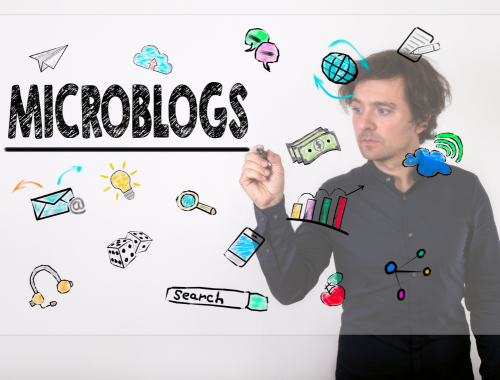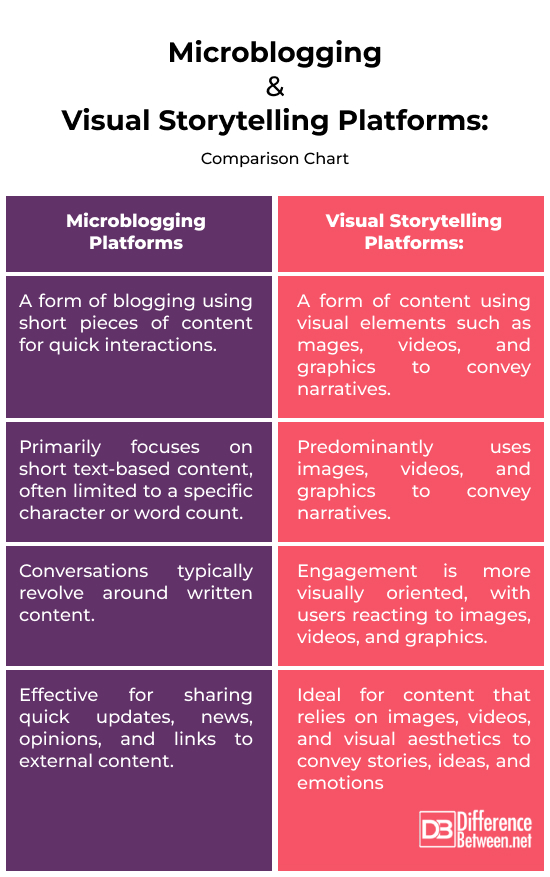Difference Between Microblogging and Visual Storytelling Platforms
The social media landscape has been evolving at a lightning pace, and this evolution has brought about significant changes in how we create and consume content. One of the key transformations we’ve witnessed is the rise of microblogging and visual storytelling platforms. These platforms have fundamentally shaped the user’s experience with content creation.
These platforms have not only made content creation more accessible but also fostered creativity and diversity in the content landscape. In this article, we delve deep into these platforms and look into the differences between microblogging and visual storytelling platforms.

What are microblogging platforms?
Microblogging is a form of social media where users can share brief, concise, and often real-time updates with their followers. These updates are typically limited in length, making them shorter than traditional blog posts. Microblogging is an effective way to share information, ideas, opinions, and knowledge on various topics. It’s often used for educational, promotional, and informative purposes.
Some popular microblogging platforms include X (formerly Twitter), Tumblr, Instagram, Pinterest, LinkedIn, Facebook, and more.
Microblogging platforms have become essential tools for both individuals and businesses to connect, engage, and share content in a fast-paced, easily digestible format. They are easily accessible to a wide range of users, and the short format of posts makes it easy for people to engage with the content quickly.

What are visual storytelling platforms?
Visuals have the power to simplify and convey complex concepts and information in a digestible and memorable way. They can break down language barriers and make content accessible to a global audience.
Now, visual storytelling platforms are online spaces where users can convey stories, messages, and information primarily through images, videos, and graphics. These platforms have gained immense importance in the digital age due to their ability to engage, inform, and entertain audiences in a highly visual and interactive manner.
Popular platforms include Instagram, YouTube, TikTok, Vimeo, Piktochart, Uberflip, Visme, WeVideo, etc. These platforms offer endless possibilities for content creators, marketers, and individuals to share their stories, ideas, and creativity with a global audience. They have become integral to shaping the way we consume and interact with content.
Differences between Microblogging and Visual Storytelling Platforms
Content
Microblogging platforms primarily focus on short text-based content, often limited to a specific character or word count, such as Twitter’s 280-character tweets. Visual storytelling platforms predominantly use images, videos, and graphics to convey narratives. Text often plays a supporting role too.
Engagement
Interaction often involves text-based responses, such as comments, likes, or retweets. Conversations typically revolve around written content. In the case of visual storytelling platforms, engagement is more visually-oriented, and users react to images, videos, and graphics. Comments and feedback are often related to the visual elements.
Audience
Microblogs are effective for sharing quick updates, news, opinions, and links to external content. They cater to users who prefer text-based information. Visual storytelling platforms are ideal for content that relies on images, videos, and visual aesthetics to convey stories, ideas, and emotions. They appeal to those who respond better to visual stimuli.
Purpose
Microblogging platforms are versatile and can be used for a wide range of purposes, including news dissemination, networking, opinion sharing, and promotion. Visual storytelling platforms are particularly well-suited for creative expression, branding, showcasing products, conveying emotions, and educating through visually rich content.
Microblogging vs. Visual Storytelling Platforms: Comparison Chart

Summary
To sum it all up, microblogging platforms like Twitter prioritize short text-based posts, while visual storytelling platforms, such as Instagram and YouTube, focus on captivating audiences through images and videos. Microblogs encourage text interactions, while visual platforms engage users with the power of visuals, offering distinct ways to share information and stories. Overall, these platforms offer diverse avenues for engagement based on the user’s preference for text or visuals.
FAQs
What is a microblogging platform?
A microblogging platform is a social media tool where users share concise, real-time updates, often limited to a specific character or word count, enabling quick and frequent communication. It’s a space for bite-sized posts.
How are microblogging platforms different from regular blogging platforms?
Unlike traditional blogs, microblogs focus on short, to-the-point content, making them ideal for fast-paced, real-time communication.
What is an example of a microblogging platform?
One of the best examples is Twitter (X). Users can post 280-character tweets to share thoughts, news, or updates with their followers in a succinct manner.
What is the difference between social networking and microblogging?
Social networking platforms enable users to create profiles, connect with others, and share various content types. Microblogging platforms, on the other hand, emphasize short, text-based updates or multimedia content in a condensed form.
What are the disadvantages of microblogging sites?
One downside to microblogging is that the space is limited for in-depth content. Also, you need to maintain a consistent posting schedule to engage the audience effectively.
Why is microblogging more popular than regular blogging?
Microblogging’s popularity can be attributed to its quick, easily digestible format that suits today’s fast-paced digital world. People find it convenient for sharing brief thoughts, news, and updates while consuming content in small, manageable portions, which aligns with their on-the-go lifestyles.
- Difference Between Caucus and Primary - June 18, 2024
- Difference Between PPO and POS - May 30, 2024
- Difference Between RFID and NFC - May 28, 2024
Search DifferenceBetween.net :
Leave a Response
References :
[0]Ojeda-Zapata, Julio. Twitter Means Business: How Microblogging Can Help or Hurt Your Company. Happy About, 2008.
[1]Orr, Tamra. Microblogging. Cherry Lake, 2019.
[2]McGee, Patricia. The Instructional Value of Digital Storytelling: Higher Education, Professional, and Adult Learning Settings. Routledge, 2014.
[3]Alexander, Bryan. The New Digital Storytelling: Creating Narratives With New Media--Revised and Updated Edition. Bloomsbury Publishing USA, 2017.
[4]Image credit: https://www.canva.com/photos/MAEVuREPuP0-woman-browsing-beautiful-and-artistic-fashion-photos-online/
[5]Image credit: https://www.canva.com/photos/MADFNTmgato-microblogs-concept-businessman/
